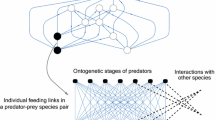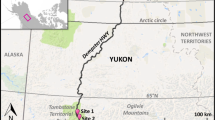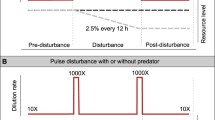Abstract
Positive or negative prey abundance covariances play an important role in determining prey preference of predators. The goal here was to understand how variations in abundance of two blowfly prey species, a native and a non-native species, influence the switching behavior and functional response of Chrysomya albiceps, an intraguild predatory blowfly, under laboratory conditions. The results suggest C. albiceps prefers to consume a native prey species rather than a non-native prey species. However, when prey densities covariate negatively, both species were consumed at the same rate, changing predator’s functional response from type II to type III. The conditions that trigger the switching behavior in blowfly communities are discussed in detail in this study.

Similar content being viewed by others
References
Abrams P (1987) The functional response of adaptive consumers of two resources. Theor Popul Biol 32:262–288
Alcock J (2001) Animal behavior. Sinauer Associates, Inc, Sunderland
Andow DA, Kareiva PM, Levin SA, Okubo A (1993) Spread of invading organisms: patterns of spread. In: Kim KC, Mcpheron BA (eds) Evolution of insect pests: patterns of variation. John Wiley, New York, pp 219–242
Baumgartner DL, Greenberg B (1984) The genus Chrysomya (Diptera: Calliphoridae) in the New World. J Med Entomol 21:105–113
Crawley MJ (2002) Statistical computing: an introduction to data analysis using S-plus. John Wiley & Sons Ltd., Chichester
De Clercq P, Mohaghegh J, Tirry L (2000) Effect of host plant on the functional response of the predator Podisus nigrispinus (Heteroptera: Pentatomide). Biol Control 18:65–70
Erzinçlioglu YZ (1990) The larvae of two closely-related blowfly species of the genus Chrysomya (Diptera, Calliphoridae). Entomol Fenn 3:151–153
Faria LDB, Costa MIS (2009) The interplay between predator’s prey preference and environmental heterogeneity in food web long-term stability. J Theor Biol 258:339–343
Faria LDB, Costa MIS (2010) Omnivorous food web, prey preference and allochthonous nutrient input. Ecol Complex 7:107–114
Faria LDB, Godoy WAC (2001) Prey choice by facultative predator larvae of Chrysomya albiceps (Diptera: Calliphoridae). Mem Inst Oswaldo Cruz 96:875–878
Faria LDB, Orsi L, Trinca LA, Godoy WAC (1999) Larval predation by Chrysomya albiceps on Cochliomyia macellaria, Chrysomya megacephala and Chrysomya putoria. Entomol Exp App 90:149–155
Faria LDB, Godoy WAC, Trinca LA (2004a) Dynamics of handling time and functional response by larvae of Chrysomya albiceps (Dipt., Calliphoridae) on different prey species. J Appl Entomol 128:432–436
Faria LDB, Trinca LA, Godoy WAC (2004b) Cannibalistic behavior and fucntional response in Chrysomya albiceps (Diptera: Calliphoridae). J Insect Behav 17:251–261
Faria LDB, Reigada C, Trinca LA, Godoy WAC (2007) Foraging behaviour by an intraguild predator blowfly, Chrysomya albiceps (Diptera: Calliphoridae). J Ethol 25:287–294
Grassberger M, Friedrich E, Reiter C (2003) The blowfly Chrysomya albiceps (Weidemann) (Diptera: Calliphoridae) as a new forensic indicator in Central Europe. Int J Legal Med 117:75–81
Greenberg B, Szyska ML (1984) Immature stages and biology of fifteen species of peruvian Calliphoridae (Diptera). Ann Entomol Soc Am 77:488–517
Guimarães JH, Prado AP, Linhares AX (1978) Three newly introduced blowfly species in Southern Brazil (Diptera: Calliphoridae). Rev Bras Entomol 22:53–60
Guimarães JH, Prado AP, Buralli GM (1979) Dispersal and distribution of three newly introduced species of Chrysomya Robineau-Desvoidy in Brazil (Diptera, Calliphoridae). Rev Bras Entomol 23:245–255
Hassell MP (1978) The dynamics of arthropod predator–prey systems. Princeton University Press, Princeton
Hengeveld R (1989) Dynamics of biological invasions. Chapman and Hall, New York
Holling CS (1959) Some characteristics of simple types of predation and parasitism. Can Entomol 91:385–398
Holt RD (1977) Predation, apparent competition, and the structure of prey communities. Theor Popul Biol 12:197–229
Holt RD (1983) Optimal foraging and the form of predator isocline. Am Nat 122:521–541
Jeschke JM, Kopp M, Tollrian R (2002) Predator functional responses: discriminating between handling and digesting prey. Ecol Monogr 72(1):95–112
Juliano SA (1993) Nonlinear curve fitting: predation and functional response curves. In: Scheiner SM, Gurevitch J (eds) Design and analysis of ecological experiments. Chapman & Hall, New York, pp 178–196
McCann K (2000) The diversity-stability debate. Nature 405:228–233
Molozov A (2010) Emergence of Holling type III zooplankton functional response: bringing together field evidence and mathematical modelling. J Theor Biol 265:45–54
Morozov A, Petrovskii S (2013) Feeding on multiple sources: towards a universal parameterization of the functional response of a generalist predator allowing for switching. PLoS ONE 8(9):e74586. doi:10.1371/journal.pone.0074586
Murdoch WW (1969) Switching in general predators: experiments in predator specificity and stability of prey population. Ecol Monogr 39:335–354
Murdoch WW, Oaten A (1975) Predation and population stability. Adv Ecol Res 9:2–131
Oaten A, Murdoch WW (1975) Switching, functional response, and stability in predator–prey systems. Am Nat 109(967):299–318
Post DM, Conners EM, Goldberg DS (2000) Prey preference by a top predator and the stability of linked food chains. Ecology 81:8–14
Prins AJ (1982) Morphological and biological notes on six African blowflies (Diptera, Calliphoridae) and this immature stages. Ann S Afr Mus 90:201–217
Queiroz MMC, Mello RP, Lima MM (1997) Morphological aspects of the larval instars of Chrysomya albiceps (Diptera, Calliphoridae) reared in the laboratory. Mem Inst Oswaldo Cruz 92:187–196
R Development Core Team 2.14. (2011) R: a language and environment for statistical computing. Vienna: R Foundation for Statistical Computing. Available: http://www.rproject.org/. Accessed 10 December 2011
Rosenzweig ML (1971) Paradox of enrichment: destabilization of exploitation ecosystems in ecological time. Science 171(969):385–387
Simberloff D (1991) Keystone species and community effects of biological introductions. In: Ginzburg LR (ed) Assessing the ecological risks of biotechnology. Butterworth-Heinemann, Boston, pp 1–19
Solomon ME (1949) The natural control of animal populations. J Anim Ecol 18:1–35
Taylor RJ (1984) Predation. Chapman and Hall, New York
Tilman D, Lehman CL, Bristow CE (1998) Diversity-stability relationships: statistical inevitability or ecological consequence? Am Nat 151:277–282
Turchin P (2003) Complex population dynamics: a theoretical/empirical synthesis. Princeton University Press, Princeton
Van Baalen M, Krivan V, VanRijn PCJV, Sabelis MW (2001) Alternative food, switching predators, and the persistence of predator–prey systems. Am Nat 157(5):1–13
Van Leeuwen E, Jansen VAA, Bright PW (2007) How population dynamics shape the functional response in a one-predator-two-prey system. Ecology 88:1571–1581
Zuharah WF, Lester PJ (2011) Are exotic invaders less susceptible to native predators? A test using native and exotic mosquitos species in New Zealand. Popul Ecol 53:307–317
Acknowledgements
Lucas D. B. Faria thanks São Paulo Research Foundation (FAPESP) and National Council for Scientific and Technological Development (CNPq) for their financial support. Carolina Reigada and Wesley A. C. Godoy also thank São Paulo Research Foundation (FAPESP).
Author information
Authors and Affiliations
Corresponding author
Electronic supplementary material
Below is the link to the electronic supplementary material.
ESM 1
(DOC 70 kb)
Rights and permissions
About this article
Cite this article
Faria, L.D.B., Tuller, J., Maia, L.F. et al. Alternative Prey and Abundance Covariance Switches an Intraguild Predator’s Functional Response. J Insect Behav 27, 503–513 (2014). https://doi.org/10.1007/s10905-014-9445-5
Revised:
Accepted:
Published:
Issue Date:
DOI: https://doi.org/10.1007/s10905-014-9445-5




